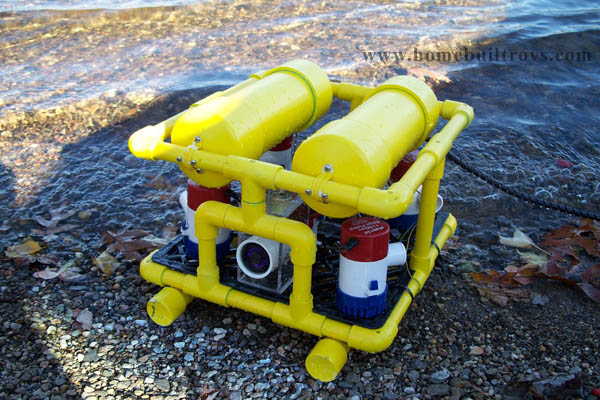Building a DIY ROV
Published: August 02, 2010Tags: untagged
I've decided to undertake the project of building myself a Remotely Operated Vehicle, or ROV. Despite sounding quite general, the term ROV appears to be applied exclusively toremotely operated underwater vehicles - basically, robot submarines - rather than just any kind of vehicle which is remotely operated. "Real" ROVs, like the Seaeye Falcon, pictured below

are capable of diving hundreds of metres under the surface of the ocean and find a wide range of applications in both the commercial world (underwater oil drilling operations being a topical example) and the scientific research community. They're fairly pricey too, with even the most basic models - which basically consist of a camera and some light - costing tens of thousands of dollars. However, a surprisingly large number of hobbyists have managed to build capable "hobby ROVs" for only a few hundred dollars, such as the Seafox, pictured below:

The precise designs of these hobby ROVs varies somewhat, but there are a few things that they all seem to have in common, which contribute to their simple construction and low cost:
- They use standard PVC pipe and fittings as their main structural components
- They use small 12V DC electric boat bilge pump as their main means of propulsion
- They use common, non-waterproof devices like webcams mounted in watertight containers for the onboard electronics
I've done some fairly thorough scouring of the web for resources on how to build these things. As near as I can tell, the hobby ROV movement began, or at the very least was widely popularised by the book "Build Your Own Underwater Robot And Other Wet Projects", which includes complete designs for two PVC ROVs, the Seaperch and the Seafox (pictured above). The book is fairly cheap, but there is so much information about these kinds of vehicles online now that you probably don't need to buy one unless you're unfamiliar with basic electronics, like using relays - I don't plan to buy the book unless I run into trouble. Far and away the best online resource for building hobby ROVs seems to be the Homebuilt ROVs page by Stephen Thone, who has built a number of ROVs, most of them of his own design. The image of the Seafox above is of the Seafox he built. Some other decent resources are:
- Hobby Submarines (featuring a slightly modified Seafox)
- Underwater ROV at instructables.com
- How to build an underwater robot, at eHow (the ROV shown here is named "Bob")
In some ways this is a bit of an odd project for me to undertake, in that I'm not much of a water person. I'm not afraid of water by any means, but I'm not really into fishing, boating, swimming, diving, etc. like a lot of people who build these things seem to be. However, while most of my projects are software-based, I have always enjoyed making "real things", and for a long time I've wanted a project I could use to deepen my understanding of electronics (which was probably my first serious hobby when I was a young kid, before I had access to the internet or even computers). In particular I've always wanted to have an excuse to buy and learn to use something like the very popular Arduino boards, but nothing has really grabbed me yet. ROVs seem like a great candidate for such a project, though, in that they don't require a lot of space or tooling to construct (I don't currently have regular access to a large shed or any tools, I don't know how to weld, etc.), they don't need to be precisely built (unlike, say, UAVs, which would otherwise be an awesome hobby and for many people are), none of their components require special training or licenses (unlike model rockets), there aren't any issues with government regulations (unlike the high-altitude balloon projects which are currently extremely popular), and it seems unlikely that simple mistakes could result in catastrophic failures: most ROVs are designed to be slightly positively buoyant, so that a broken tether or flat batteries means the ROV will slowly rise back to the surface of the water, rather than sink to the bottom.
I've decided to build a very simple ROV first to get my feet wet (figuratively and literally!), probably just something with the bare minimum number of thrusters to get around, a camera and some lights, before moving onto something more complex. Rather than strictly following the Seafox design like lots of other people do, I've decided to use the "Bob" ROV as a starting point, because its frame/shape strikes me as more efficient than the Seafox, which is really rather chunky. So today I headed to my local hardware store and bought a bunch of 15 mm PVC pipe and fittings to use for the main frame of the ROV and some 90 mm PVC pipe to use for buoyancy pods, as well as other associated stuff like PVC cement, a hacksaw, sandpaper, some cable ties, etc. I'll try my best to make regular posts about the construction process.
After testing the water with a really simple ROV I might have a go at designing something more complicated, from scratch. I'm particularly interested in building a complex navigation system: GPS doesn't work under water, since EM radiation at the appropriate frequency only penetrates water a few centimeters deep. This means ROVs need to rely on things like digital compasses, accelerometers, gyroscopes, sonar and laser rangers to find their way around underwater - lots of fun stuff and plenty of opportunities for learning.